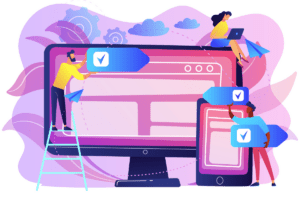B2B marketing has always been complex, but in recent years it has become even more difficult for companies to stand out and connect with their target audience. While there are more tools, channels, and strategies available than ever before, that also means more competition, higher costs, and new challenges that marketers didn’t face just a few years ago. In this article, we’ll explore the biggest marketing challenges that B2B companies face. For each challenge, we’ll break down the problem, why it happens, and practical ways you can address it.
Ranking on Search Engines
Search engine optimization, or SEO, has always been an important part of B2B marketing. Ranking for relevant keywords brings qualified visitors to your website and can generate leads consistently over time. The problem is that ranking has become increasingly difficult.
Why It Happens
Traditional SEO is no longer just about keyword placement and backlinks. Search engines like Google prioritize high-quality content, fast load times, strong mobile usability, and user engagement. On top of that, the introduction of AI-driven search engines and new features like zero-click results has made it harder for companies to earn clicks. According to HubSpot, nearly 60% of Google searches now end without a click, meaning even if your page ranks, fewer users are visiting your site.
How to Solve It
The key is to shift focus from simply ranking to creating content that searchers find valuable enough to click on. Write content that answers specific questions, provides unique insights, and showcases your expertise. Structured data, clear titles, and meta descriptions that invite curiosity can help attract clicks. For AI-driven search engines, prioritize clarity, authority, and consistency across your site, since these factors are more likely to be pulled into AI-generated answers.
Increasing Website Traffic but Not Conversions
Many B2B companies manage to bring in website traffic through content, ads, and SEO, but then find that traffic doesn’t convert into leads or sales. This can be one of the most frustrating challenges because it feels like your marketing is working, but your pipeline isn’t growing.
Why It Happens
There are several reasons why visitors don’t convert. Sometimes the wrong audience is being targeted, leading to unqualified traffic. Other times, the website fails to clearly communicate value or lacks strong calls-to-action. In B2B specifically, long buying cycles mean that even qualified visitors may leave before filling out a form.
How to Solve It
Conversion rate optimization should be a priority. Start by analyzing visitor behavior to understand where users drop off. Tools like Visitor Queue can show you which companies are visiting and give you insight into whether the right audience is arriving. Improve website messaging so that it clearly states the benefits of your solution. Provide multiple ways to convert, such as gated resources, demo requests, or newsletter sign-ups. Even if someone isn’t ready to buy today, capturing their information helps you nurture them over time. Try Visitor Queue for free today and stop losing leads.

Spending Too Much on Paid Ads
Paid advertising can deliver fast results, but for many B2B marketers, ad budgets can spiral out of control without delivering sustainable ROI.
Why It Happens
Competition is high on platforms like Google Ads and LinkedIn, where multiple companies bid on the same audience. High cost-per-click rates are common in industries like technology, software, and professional services. Additionally, if ad campaigns are not well-targeted, you may be paying for impressions and clicks that never turn into meaningful leads.
How to Solve It
Instead of pouring money into broad ad campaigns, focus on hyper-targeting. Segment audiences by industry, company size, or job title to ensure your ads are reaching the right decision-makers. Continuously test different ad creatives and landing pages to improve performance. At the same time, balance paid ads with organic strategies so you’re not reliant on constant ad spend to generate traffic. Paid ads should support your pipeline, not replace other channels entirely.
Generating High-Quality Leads
Traffic is one thing, but B2B companies often struggle with the quality of the leads that come in. A high number of unqualified leads wastes time and resources, making sales teams less effective.
Why It Happens
This challenge usually stems from either overly broad marketing tactics or misalignment between marketing and sales. If your messaging is not specific enough, you may attract companies that don’t actually fit your ideal customer profile. Miscommunication between teams can also cause marketing to prioritize volume while sales focuses on quality.
How to Solve It
The solution starts with a clearly defined ideal customer profile and buyer personas. Both marketing and sales should align on what qualifies as a good lead. Then, tailor your content, ads, and outreach strategies to target that audience. Instead of generic campaigns, create industry-specific resources or case studies that speak directly to your target customer’s pain points. Lead scoring and regular communication between marketing and sales will help ensure that both teams are working toward the same goals.
Adapting to AI Search
The way people search for and consume information is changing. AI-driven search engines, chatbots, and automated recommendations are reshaping how buyers discover solutions. For B2B companies that have relied on traditional SEO and outbound sales tactics, this shift can feel overwhelming.
Why It Happens
AI-powered platforms prioritize context and authority over keyword stuffing. They also often provide answers directly on the results page, reducing clicks to actual websites. Companies that haven’t adapted their content strategy to fit these systems risk losing visibility.
How to Solve It
Focus on building thought leadership and authority in your niche. Publish content that is well-structured, factually accurate, and provides original insights. Updating older content to improve accuracy and readability can also help. Beyond SEO, diversify how you connect with your audience by investing in email marketing, social engagement, and events that AI cannot replicate.

Long and Complex Sales Cycles
Unlike B2C, B2B purchases often involve multiple decision-makers, long research phases, and careful budget considerations. This extended cycle makes it harder for marketing teams to prove ROI quickly.
Why It Happens
High-ticket B2B products and services typically require input from executives, IT, finance, and end-users. Each stage of approval adds time, and without consistent engagement, potential deals can stall or disappear.
How to Solve It
Content marketing and nurturing campaigns are critical. Create resources tailored to each stage of the buyer’s journey, from awareness blogs to in-depth case studies and ROI calculators. Email workflows, retargeting campaigns, and personalized outreach help keep your company top of mind. Marketing and sales alignment is also essential, as sales teams need ongoing support to provide buyers with the right resources at the right time.
Standing Out in a Crowded Market
One of the most common marketing challenges is standing out. No matter the industry, competition is intense. With so many companies offering similar products and services, B2B marketers often struggle to stand out.
Why It Happens
When every competitor is saying the same things about efficiency, cost savings, or innovation, prospects have difficulty telling them apart. A lack of differentiation leads to decision-making based on price alone, which hurts profitability.
How to Solve It
Develop a strong brand positioning that goes beyond features and pricing. Highlight the unique value that only your company provides, whether it’s exceptional customer support, industry expertise, or proven results. Storytelling can also help humanize your brand and make it more memorable. Share customer success stories and insights from your team to show why working with your company is different.
Measuring ROI from Marketing Efforts
Marketers are often under pressure to prove the value of their campaigns, but measuring ROI can be challenging in B2B where the buying journey is long and multi-touch.
Why It Happens
Attribution is complicated when a prospect interacts with multiple pieces of content, ads, and emails before converting. If your data tracking isn’t set up correctly, it becomes nearly impossible to identify which efforts are driving results.
How to Solve It
Implement strong tracking and reporting systems. Use CRM and marketing automation tools that integrate seamlessly, so you can track leads from their first interaction to closed deals. Instead of relying only on last-click attribution, look at the full buyer journey. Regularly report not just on leads, but on pipeline impact and revenue influenced by marketing. This helps demonstrate the true value of your efforts.

Keeping Up With Content Demands
The next marketing challenge that we are going to review is keeping up with content. Content is essential for SEO, social media, email, and lead nurturing, but many B2B companies struggle to produce enough high-quality content to support all these channels.
Why It Happens
Producing well-researched, professional content takes time, and many marketing teams are already stretched thin. In B2B specifically, content often requires subject matter expertise, which can be hard to source internally.
How to Solve It
Create a content strategy that focuses on quality over quantity. Repurpose existing assets into multiple formats, such as turning a whitepaper into blog posts, social snippets, and email campaigns. Collaborate with subject matter experts within your company to ensure accuracy and depth. Outsourcing some content creation to trusted partners can also help keep up with demand without sacrificing quality.
Aligning Marketing and Sales
Perhaps the most universal challenge in B2B marketing is the gap between marketing and sales teams. When these two groups are not aligned, leads can fall through the cracks and opportunities are missed.
Why It Happens
Marketing often focuses on generating leads, while sales focuses on closing deals. Without consistent communication, marketing may deliver leads that sales considers unqualified, creating frustration on both sides.
How to Solve It
Set shared goals that both teams are accountable for, such as revenue targets instead of just lead numbers. Regular meetings and clear feedback loops help improve collaboration. Marketing can support sales with content, while sales can provide feedback on lead quality and customer needs. When both teams work together, the customer experience improves and results follow.
What’s Next?
When you focus on solving the root causes of your marketing challenges, rather than just addressing the symptoms, you’ll find it easier to generate qualified leads, prove ROI, and ultimately drive business growth. As always, if you have any questions about how Visitor Queue can help your team generate leads, do not hesitate to reach out.
 Identify
Identify Personalize
Personalize Benchmark
Benchmark Agencies
Agencies Integrations
Integrations Case Studies
Case Studies Use Cases
Use Cases Blog
Blog Resources
Resources









